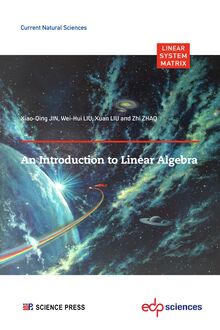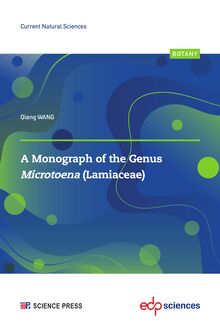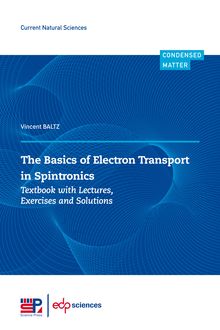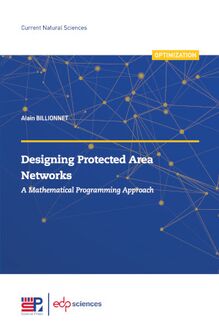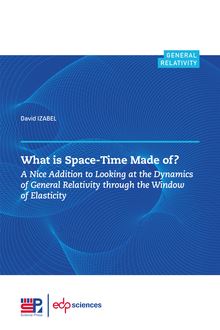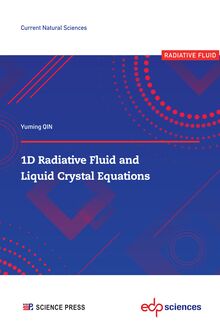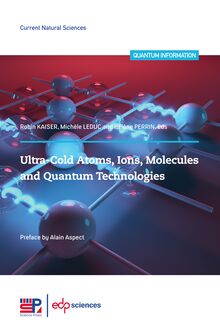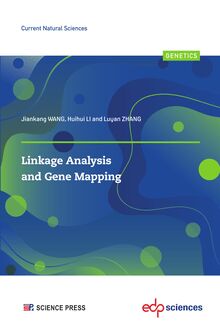Synthesis and biomedical applications of magnetic nanomaterials , livre ebook
396
pages
English
Ebooks
2022
Obtenez un accès à la bibliothèque pour le consulter en ligne En savoir plus
Découvre YouScribe en t'inscrivant gratuitement
Découvre YouScribe en t'inscrivant gratuitement
396
pages
English
Ebooks
2022
Obtenez un accès à la bibliothèque pour le consulter en ligne En savoir plus
Publié par
Date de parution
15 février 2022
Nombre de lectures
2
EAN13
9782759827152
Langue
English
Poids de l'ouvrage
424 Mo
This book aims to address cutting-edge progress in the area of synthesisand biomedical applications of magnetic nanomaterials. It compiles a broadspectrum from fundamental principles to technological advances, from synthesisand modification to biomedical applications along with biocompatibility. Themain topics include principles in nanomagnetism, technologies for magneticnanomaterials fabrication, developments in their biomedical applications, andthe challenges in the toxicity in clinical translation. The first partintroduced the principles of nanomagnetism and specific properties in magnetic nanomaterials.Then, some typical fabrication strategies in magnetic nanomaterials forcontrolled composition, morphologies and sizes are reviewed; and surfacemodification methods with better hydrophilcity and biocompatibility arepresented. Next, magnetic nanomaterials-based applications in biomedical fieldare highlighted in detail, mainly including magnetic resonance image, magnetic hyperthermia,cancer therapy, multi-mode imaging, imaging-guided therapy and manipulatebiological objects. Finally, biocompatibility issues caused by magneticnanomaterials are also overviewed.
Foreword
Preface
Introduction
Chapter 1 Nanomagnetism: Principles, Nanostructures, and Biomedical Applications . . . . . . . . . . . . . . . . . . . . . . . . . . . . . . . . . . . . . . . 3
1.1 Introduction . . . . . . . . . . . . . . . . . . . . . . . . . . . . . . . . . . . . . . . . . . . . . . . . . . . . . . . . . . . . 3
1.2 Nanomagnetic e®ects . . . . . . . . . . . . . . . . . . . . . . . . . . . . . . . . . . . . . . . . . . . . . . . . . . . 4
1.2.1 Single domain and superparamagnetism . . . . . . . . . . . . . . . . . . . . . . . . . . . . . . 4
1.2.2 Exchange-coupling e®ect . . . . . . . . . . . . . . . . . . . . . . . . . . . . . . . . . . . . . . . . . . . . 6
1.2.3 Exchange bias e®ect . . . . . . . . . . . . . . . . . . . . . . . . . . . . . . . . . . . . . . . . . . . . . . . . 9
1.3 Magnetism of nanomaterials . . . . . . . . . . . . . . . . . . . . . . . . . . . . . . . . . . . . . . . . . . . 12
1.3.1 Magnetism of NPs. . . . . . . . . . . . . . . . . . . . . . . . . . . . . . . . . . . . . . . . . . . . . . . . .12
1.3.2 Magnetism of nanoplates . . . . . . . . . . . . . . . . . . . . . . . . . . . . . . . . . . . . . . . . . . 12
1.3.3 Magnetism of nanorings . . . . . . . . . . . . . . . . . . . . . . . . . . . . . . . . . . . . . . . . . . . 13
1.4 Biomedical applications of nanomagnetism . . . . . . . . . . . . . . . . . . . . . . . . . . . . . 14
1.4.1 T2 MRI contrast agents . . . . . . . . . . . . . . . . . . . . . . . . . . . . . . . . . . . . . . . . . . . 14
1.4.2 Magnetic hyperthermia . . . . . . . . . . . . . . . . . . . . . . . . . . . . . . . . . . . . . . . . . . . 16
1.4.3 Biosensors . . . . . . . . . . . . . . . . . . . . . . . . . . . . . . . . . . . . . . . . . . . . . . . . . . . . . . . 16
1.5 Conclusion . . . . . . . . . . . . . . . . . . . . . . . . . . . . . . . . . . . . . . . . . . . . . . . . . . . . . . . . . . . . 17
References . . . . . . . . . . . . . . . . . . . . . . . . . . . . . . . . . . . . . . . . . . . . . . . . . . . . . . . . . . . . . . . . . 17
Controlled Synthesis and Modi¯cation
Chapter 2 Chemical Synthesis of Magnetic Nanocrystals: Recent Progress . . . . . . . . . . . . . . . . . . . . . . . . . . . . . . . . . . . . 23
2.1 Introduction . . . . . . . . . . . . . . . . . . . . . . . . . . . . . . . . . . . . . . . . . . . . . . . . . . . . . . . . . . . 24
2.2 Chemical synthesis of single-component magnetic NCs . . . . . . . . . . . . . . . . . 25
2.2.1 Metal oxides . . . . . . . . . . . . . . . . . . . . . . . . . . . . . . . . . . . . . . . . . . . . . . . . . . . . . . 25
2.2.2 Metals and alloys. . . . . . . . . . . . . . . . . . . . . . . . . . . . . . . . . . . . . . . . . . . . . . . . . .29
2.2.3 Metal carbides, phosphides, and chalcogenides . . . . . . . . . . . . . . . . . . . . . . . 33
2.3 Chemical synthesis of multi-component magnetic NCs. . . . . . . . . . . . . . . . . .38
2.3.1 Core/shell heterostructure . . . . . . . . . . . . . . . . . . . . . . . . . . . . . . . . . . . . . . . . . 39
2.3.2 Oligomer-like heterostructure . . . . . . . . . . . . . . . . . . . . . . . . . . . . . . . . . . . . . . .44
2.3.3 Anisotropically shaped material-based heterostructure . . . . . . . . . . . . . . . . 49
2.4 Chemical synthesis of hollow/porous magnetic NCs . . . . . . . . . . . . . . . . . . . . 53
2.4.1 Fe-based hollow/porous NCs . . . . . . . . . . . . . . . . . . . . . . . . . . . . . . . . . . . . . . . 53
2.4.2 Mn-based hollow/porous NCs . . . . . . . . . . . . . . . . . . . . . . . . . . . . . . . . . . . . . . 56
2.5 Summary and perspectives . . . . . . . . . . . . . . . . . . . . . . . . . . . . . . . . . . . . . . . . . . . . .57
References . . . . . . . . . . . . . . . . . . . . . . . . . . . . . . . . . . . . . . . . . . . . . . . . . . . . . . . . . . . . . . . . . . 58
Chapter 3 Magnetic Iron Oxide Nanoparticles: Synthesis and Surface Coating Techniques for Biomedical Applications. . . .68
3.1 Introduction . . . . . . . . . . . . . . . . . . . . . . . . . . . . . . . . . . . . . . . . . . . . . . . . . . . . . . . . . . . 69
3.2 Fe3O4 and °-Fe2O3 . . . . . . . . . . . . . . . . . . . . . . . . . . . . . . . . . . . . . . . . . . . . . . . . . . . . 70
3.3 Size-induced magnetism evolution and application mechanisms . . . . . . . . . 72
3.4 Synthesis approaches . . . . . . . . . . . . . . . . . . . . . . . . . . . . . . . . . . . . . . . . . . . . . . . . . . 74
3.4.1 Physical vapor deposition (PVD) . . . . . . . . . . . . . . . . . . . . . . . . . . . . . . . . . . . 74
3.4.2 Chemical vapor deposition (CVD) . . . . . . . . . . . . . . . . . . . . . . . . . . . . . . . . . . 75
3.4.3 Electrodeposition . . . . . . . . . . . . . . . . . . . . . . . . . . . . . . . . . . . . . . . . . . . . . . . . . .75
3.4.4 Hydrothermal synthesis . . . . . . . . . . . . . . . . . . . . . . . . . . . . . . . . . . . . . . . . . . . . 76
3.4.5 Co-precipitation . . . . . . . . . . . . . . . . . . . . . . . . . . . . . . . . . . . . . . . . . . . . . . . . . . .78
3.4.6 High-temperature (thermal) decomposition of organometallic precursors . . . . . . . . . . . . . . . . . . . . . . . . . . . . . . . . . . 80
3.5 Surface coating for biomedical application. . . . . . . . . . . . . . . . . . . . . . . . . . . . . .88
3.5.1 Au coating. . . . . . . . . . . . . . . . . . . . . . . . . . . . . . . . . . . . . . . . . . . . . . . . . . . . . . . .88
3.5.2 SiO2 coating . . . . . . . . . . . . . . . . . . . . . . . . . . . . . . . . . . . . . . . . . . . . . . . . . . . . . . 91
3.5.3 TaOx coating . . . . . . . . . . . . . . . . . . . . . . . . . . . . . . . . . . . . . . . . . . . . . . . . . . . . . 94
3.5.4 Polymer coating . . . . . . . . . . . . . . . . . . . . . . . . . . . . . . . . . . . . . . . . . . . . . . . . . . .95
3.5.5 Small molecular coating . . . . . . . . . . . . . . . . . . . . . . . . . . . . . . . . . . . . . . . . . .100
3.5.6 Carbon coating . . . . . . . . . . . . . . . . . . . . . . . . . . . . . . . . . . . . . . . . . . . . . . . . . . 103
3.6 Conclusions and perspectives . . . . . . . . . . . . . . . . . . . . . . . . . . . . . . . . . . . . . . . . . 104
References . . . . . . . . . . . . . . . . . . . . . . . . . . . . . . . . . . . . . . . . . . . . . . . . . . . . . . . . . . . . . . . . . 105
Chapter 4 Surface Modi¯cation of Magnetic Nanoparticles in Biomedicine. . . . . . . . . . . . . . . . . . . . .112
4.1 Introduction . . . . . . . . . . . . . . . . . . . . . . . . . . . . . . . . . . . . . . . . . . . . . . . . . . . . . . . . . . 112
4.2 Surface modi¯cation with organic molecules. . . . . . . . . . . . . . . . . . . . . . . . . . .114
4.3 Coating modi¯cation with macromolecules . . . . . . . . . . . . . . . . . . . . . . . . . . . . 117
4.3.1 Polymer coating. . . . . . . . . . . . . . . . . . . . . . . . . . . . . . . . . . . . . . . . . . . . . . . . . .117
4.3.2 Liposome and micelle encapsulation . . . . . . . . . . . . . . . . . . . . . . . . . . . . . . . 120
4.4 Coating modification with inorganic materials . . . . . . . . . . . . . . . . . . . . . . . . 120
4.4.1 Silica coating . . . . . . . . . . . . . . . . . . . . . . . . . . . . . . . . . . . . . . . . . . . . . . . . . . . . 120
4.4.2 Metal element coating . . . . . . . . . . . . . . . . . . . . . . . . . . . . . . . . . . . . . . . . . . . 122
4.5 Conclusions and outlook . . . . . . . . . . . . . . . . . . . . . . . . . . . . . . . . . . . . . . . . . . . . . . 124
References . . . . . . . . . . . . . . . . . . . . . . . . . . . . . . . . . . . . . . . . . . . . . . . . . . . . . . . . . . . . . . . . . 125
Diagnosis and Therapy
Chapter 5 Magnetic Nanoparticle-Based Cancer Nanodiagnostics . . 133
5.1 Introduction . . . . . . . . . . . . . . . . . . . . . . . . . . . . . . . . . . . . . . . . . . . . . . . . . . . . . . . . . . 134
5.2 Magnetic resonance imaging . . . . . . . . . . . . . . . . . . . . . . . . . . . . . . . . . . . . . . . . . . 136
5.3 Diagnostic magnetic resonance . . . . . . . . . . . . . . . . . . . . . . . . . . . . . . . . . . . . . . . .164
5.4 Multifunctional MNPs for multimodal probing . . . . . . . . . . . . . . . . . . . . . . . 166
5.5 Conclusion and future prospects . . . . . . . . . . . . . . . . . . . . . . . . . . . . . . . . . . . . . . 172
References . . . . . . . . . . . . . . . . . . . . . . . . . . . . . . . . . . . . . . . . . . . . . . . . . . . . . . . . . . . . . . . . . 174
Chapter 6 Magnetic Microbubble: A Biomedical Platform Co-constructed from Magnetics and Acoustics. . . . . . . . . . . . 183
6.1 Introduction . . . . . . . . . . . . . . . . . . . . . . . . . . . . . . . . . . . . . . . . . . . . . . . . . . . . . . . . . . 183
6.2 Magnetic nanoparticles and magnetic characteristics . . . . . . . . . . . . . . . . . . 185
6.2.1 Preparation, surface modi¯cation, assembly of magnetic
nanoparticles . . . . . . . . . . . . . . . . . . . . . . . . . . . . . . . . . . . . . . . . . . . . . . . . . . . . 185
6.2.2 Special features of magnetic nanoparticles . . . . . . . . . . . . . . . . . . . . . . . . . . 186
6.2.3 Biomedical applications of magnetic nanoparticles . . . . . . . . . . . . . . . . . . 190
6.2.4 Ultrasonic characteristics of magnetic nanoparticles liquid . . . . . . . . . . . 192
6.3 Microbubble formalism and acoustic characteristics . . . . . . . . . . . . . . . . . . . 193
6.3.1 Design and preparation of microbubbles . . . . . . . . . . . . . . . . . . . . . . . . . . . .193
6.3.2 Actions of MBs with ultrasound waves . . . . . . . . . . . . . . . . . . . . . . . . . . . . . 194
6.4 Magnetic and acoustic character of magnetic microbubbles (MMBs). . .197
6.4.1 Fabrication of magnetic microbubbles . . . . . . . . . . . . . . . . . . . . . . . . . . . . . . 197
6.4.2 Acoustic response of magnetic microbubbles . . . . . . . . . . . . . . . . . . . . . . . . 198
6.4.3 Magnetic response of magnetic microbubbles . . . . . . . . . . . . . . . . . . . . . . . 200
6.5 Applications of magnetic microbubbles in biomedicine . . . . . . . . . . . . . . . . 203
6.5.1 Multimodal imaging of MMBs. . . . . . . . . . . . . . . . . . . . . . . . . . . . . . . . . . . . .203
6.5.2 Ultrasound assisted drug delivery of MMBs . . . . . . . . . . . . . . . . . . . . . . . . 204
6.5.3 Magnetic ¯eld-controlled drug delivery and release of MMBs. . . . . . . . . 204
6.6 Summary and perspectives. . . . . . . . . . . . . . . . . . . . . . . . . . . . . . . . . . . . . . . . . . . .205
6.6.1 MMBs as physical triggering smart drug delivery system . . . . . . . . . . . . 206
6.6.2 MMBs for gene delivery . . . . . . . . . . . . . . . . . . . . . . . . . . . . . . . . . . . . . . . . . .206
6.6.3 MMBs for treating diseases of the central nervous system. . . . . . . . . . . .207
References . . . . . . . . . . . . . . . . . . . . . . . . . . . . . . . . . . . . . . . . . . . . . . . . . . . . . . . . . . . . . . . . . 208
Chapter 7 Multifunctional Magnetic Nanoparticles for Magnetic Resonance Image-guided Photothermal Therapy for Cancer. . . .213
7.1 Introduction . . . . . . . . . . . . . . . . . . . . . . . . . . . . . . . . . . . . . . . . . . . . . . . . . . . . . . . . . . 213
7.2 ICG-loaded MNPs for MR/°uorescence bimodal image-guided PTT. . . 215
7.2.1 Fabrication of ICG-loaded SPIO NPs . . . . . . . . . . . . . . . . . . . . . . . . . . . . . . 215
7.2.2 In vivo MR/°uorescence bimodal imaging of ICG-loaded SPIO NPs . . 216
7.2.3 In vivo photothermal therapy with ICG-loaded SPIO NPs . . . . . . . . . . . 218
7.3 Gold-nanoshelled magnetic cerasomes for MRI-guided photothermal therapy. . . . . . . . . . . . . . . . . . . . . . . . . . . . . . . . . . . .218
7.3.1 Cerasomes combine the advantages of both liposomes and silica nanoparticles . . . . . . . . . . . . . . . . . . . . . . . . . . . . . . . . . . . 218
7.3.2 Contrast-enhanced MRI imaging using GNMCs. . . . . . . . . . . . . . . . . . . . .220
7.3.3 Synergistic e®ect in killing cancer cells using GNMCs . . . . . . . . . . . . . . . 220
7.4 Gold-nanoshelled magnetic nanocapsules for MR/ultrasound bimodal image-guided photothermal therapy . . . . . . . . . . . . . 221
7.4.1 SPIOs-embedded PFOB nanocapsules with PEGylated gold shells (PGS-SP NCs). . . . . . . . . . . . . . . . . . . . . . . .221
7.4.2 Bimodal US/MRI contrast imaging capability of PGS-SP NCs . . . . . . . 222
7.5 Conclusion and perspectives . . . . . . . . . . . . . . . . . . . . . . . . . . . . . . . . . . . . . . . . . . 224
References . . . . . . . . . . . . . . . . . . . . . . . . . . . . . . . . . . . . . . . . . . . . . . . . . . . . . . . . . . . . . . . . . 225
Chapter 8 Magnetic-mediated Hyperthermia for Cancer Treatment: Research Progress and Clinical Trials . . . . . 228
8.1 Cancer hyperthermia . . . . . . . . . . . . . . . . . . . . . . . . . . . . . . . . . . . . . . . . . . . . . . . . . 229
8.2 Overview of magnetic-mediated hyperthermia (MMH) . . . . . . . . . . . . . . . . 230
8.2.1 Working mechanism and brief introduction to MMH . . . . . . . . . . . . . . . . 230
8.2.2 Categories of MMH . . . . . . . . . . . . . . . . . . . . . . . . . . . . . . . . . . . . . . . . . . . . . . 233
8.3 Research progress of MMH . . . . . . . . . . . . . . . . . . . . . . . . . . . . . . . . . . . . . . . . . . . 234
8.3.1 IIH by thermoseeds and magnetic stent hyperthermia . . . . . . . . . . . . . . . 234
8.3.2 AEH for liver cancer . . . . . . . . . . . . . . . . . . . . . . . . . . . . . . . . . . . . . . . . . . . . . 236
8.3.3 Magnetic hyperthermia by MNPs. . . . . . . . . . . . . . . . . . . . . . . . . . . . . . . . . .237
8.4 Clinical applications of MMH. . . . . . . . . . . . . . . . . . . . . . . . . . . . . . . . . . . . . . . . . 241
8.4.1 Clinical trials of MMH by thermoseeds . . . . . . . . . . . . . . . . . . . . . . . . . . . . .241
8.4.2 Clinical trials of MSH . . . . . . . . . . . . . . . . . . . . . . . . . . . . . . . . . . . . . . . . . . . .242
8.4.3 Clinical Trials of MNH . . . . . . . . . . . . . . . . . . . . . . . . . . . . . . . . . . . . . . . . . . .243
8.4.4 Clinical trials of AEH . . . . . . . . . . . . . . . . . . . . . . . . . . . . . . . . . . . . . . . . . . . .244
8.5 Multifunctional magnetic devices for cancer multimodality treatment . . . . . . . . . . . . . . . . . . . . . . . . . . . . . . 244
8.5.1 Multifunctional magnetic device for thermoradiotherapy . . . . . . . . . . . . . 245
8.5.2 Multifunctional magnetic devices for thermochemotherapy . . . . . . . . . . . 246
8.6 Conclusions and remarks . . . . . . . . . . . . . . . . . . . . . . . . . . . . . . . . . . . . . . . . . . . . . 251
References . . . . . . . . . . . . . . . . . . . . . . . . . . . . . . . . . . . . . . . . . . . . . . . . . . . . . . . . . . . . . . . . . 252
Chapter 9 Magnetic Nanoparticle-based Cancer Therapy . . . . . . . . . . . . 261
9.1 Introduction . . . . . . . . . . . . . . . . . . . . . . . . . . . . . . . . . . . . . . . . . . . . . . . . . . . . . . . . . . 262
9.2 MNPs-based cancer therapy . . . . . . . . . . . . . . . . . . . . . . . . . . . . . . . . . . . . . . . . . . 263
9.2.1 Magnetic hyperthermia . . . . . . . . . . . . . . . . . . . . . . . . . . . . . . . . . . . . . . . . . . . 263
9.2.2 Magnetic speci¯c targeting . . . . . . . . . . . . . . . . . . . . . . . . . . . . . . . . . . . . . . . .268
9.2.3 Magnetically controlled drug delivery . . . . . . . . . . . . . . . . . . . . . . . . . . . . . . 270
9.2.4 Magnetofection . . . . . . . . . . . . . . . . . . . . . . . . . . . . . . . . . . . . . . . . . . . . . . . . . . 271
9.2.5 Magnetic switches for controlling cell fate . . . . . . . . . . . . . . . . . . . . . . . . . . 273
9.2.6 Recently developed therapies . . . . . . . . . . . . . . . . . . . . . . . . . . . . . . . . . . . . . . 277
9.3 Conclusions and perspectives . . . . . . . . . . . . . . . . . . . . . . . . . . . . . . . . . . . . . . . . . 280
References . . . . . . . . . . . . . . . . . . . . . . . . . . . . . . . . . . . . . . . . . . . . . . . . . . . . . . . . . . . . . . . . . 282
Chapter 10 Composite Magnetic Nanoparticles: Synthesis and Cancer-related Applications . . . . . . . . . . . . . . . . . . . . . . . . . . . . . . . 291
10.1 Introduction . . . . . . . . . . . . . . . . . . . . . . . . . . . . . . . . . . . . . . . . . . . . . . . . . . . . . . . . .291
10.2 Controlled synthesis of composite nanoparticles . . . . . . . . . . . . . . . . . . . . . . 292
10.2.1 Dumbbell-like nanoparticles . . . . . . . . . . . . . . . . . . . . . . . . . . . . . . . . . . . . . . 292
10.2.2 Core@shell nanoparticles. . . . . . . . . . . . . . . . . . . . . . . . . . . . . . . . . . . . . . . . .295
10.2.3 Core/satellite- or °ower-like NPs . . . . . . . . . . . . . . . . . . . . . . . . . . . . . . . . . 299
10.3 Applications . . . . . . . . . . . . . . . . . . . . . . . . . . . . . . . . . . . . . . . . . . . . . . . . . . . . . . . . .299
10.4 Summary and perspective . . . . . . . . . . . . . . . . . . . . . . . . . . . . . . . . . . . . . . . . . . . 301
References . . . . . . . . . . . . . . . . . . . . . . . . . . . . . . . . . . . . . . . . . . . . . . . . . . . . . . . . . . . . . . . . . 302
Chapter 11 Formation of Multifunctional Fe3O4/Au Composite Nanoparticles for Dual-mode MR/CT Imaging Applications . . . . . 307
11.1 Introduction . . . . . . . . . . . . . . . . . . . . . . . . . . . . . . . . . . . . . . . . . . . . . . . . . . . . . . . . .307
11.2 Synthesis or formation of Fe3O4/Au CNPs. . . . . . . . . . . . . . . . . . . . . . . . . . .309
11.2.1 \Dumbbell-like" structured CNPs . . . . . . . . . . . . . . . . . . . . . . . . . . . . . . . . 309
11.2.2 \Core/shell" structured CNPs. . . . . . . . . . . . . . . . . . . . . . . . . . . . . . . . . . . .310
11.3 Dual-mode MR/CT imaging applications of Fe3O4/Au CNPs . . . . . . . . 314
11.4 Concluding remarks and outlooks . . . . . . . . . . . . . . . . . . . . . . . . . . . . . . . . . . . .319
References . . . . . . . . . . . . . . . . . . . . . . . . . . . . . . . . . . . . . . . . . . . . . . . . . . . . . . . . . . . . . . . . . 320
Biocompatibility
Chapter 12 Using Magnetic Nanoparticles to Manipulate Biological Objects. . . . . . . .. . . . . . . . . . . . . . . . .327
12.1 Introduction . . . . . . . . . . . . . . . . . . . . . . . . . . . . . . . . . . . . . . . . . . . . . . . . . . . . . . . . .327
12.2 Protein separation . . . . . . . . . . . . . . . . . . . . . . . . . . . . . . . . . . . . . . . . . . . . . . . . . . . 329
12.3 Magnetofection . . . . . . . . . . . . . . . . . . . . . . . . . . . . . . . . . . . . . . . . . . . . . . . . . . . . . . 332
12.4 Manipulation of cellular organelles . . . . . . . . . . . . . . . . . . . . . . . . . . . . . . . . . . . 333
12.5 Separation and detection of bacteria and virus . . . . . . . . . . . . . . . . . . . . . . . 337
12.6 Manipulation of cells . . . . . . . . . . . . . . . . . . . . . . . . . . . . . . . . . . . . . . . . . . . . . . . . 341
12.7 Manipulation of organs . . . . . . . . . . . . . . . . . . . . . . . . . . . . . . . . . . . . . . . . . . . . . . 344
12.8 Magnetic micro-/nanorobots to interact with multi- scale biological objects . . . . . . . . . . . . . . . . . . . . . . . . . . . . . . . . . . . . . . 345
References . . . . . . . . . . . . . . . . . . . . . . . . . . . . . . . . . . . . . . . . . . . . . . . . . . . . . . . . . . . . . . . . . 347
Chapter 13 Toxicity of Superparamagnetic Iron Oxide Nanoparticles: Research Strategies and Implications for Nanomedicine . . 352
13.1 Introduction . . . . . . . . . . . . . . . . . . . . . . . . . . . . . . . . . . . . . . . . . . . . . . . . . . . . . . . . .353
13.2 Mechanism of toxicity . . . . . . . . . . . . . . . . . . . . . . . . . . . . . . . . . . . . . . . . . . . . . . . 353
13.3 In vitro cytotoxicity . . . . . . . . . . . . . . . . . . . . . . . . . . . . . . . . . . . . . . . . . . . . . . . . . 355
13.4 In vivo toxicity of SPIONs. . . . . . . . . . . . . . . . . . . . . . . . . . . . . . . . . . . . . . . . . . .359
13.5 Blood compatibility . . . . . . . . . . . . . . . . . . . . . . . . . . . . . . . . . . . . . . . . . . . . . . . . . 363
13.6 Biodistribution and elimination . . . . . . . . . . . . . . . . . . . . . . . . . . . . . . . . . . . . . . 363
13.7 In silico assays for nanotoxicity . . . . . . . . . . . . . . . . . . . . . . . . . . . . . . . . . . . . . . 364
13.8 Surface engineering for SPIONs-based nanomedicine . . . . . . . . . . . . . . . . . 365
13.9 Conclusions and perspectives . . . . . . . . . . . . . . . . . . . . . . . . . . . . . . . . . . . . . . . . 368
References . . . . . . . . . . . . . . . . . . . . . . . . . . . . . . . . . . . . . . . . . . . . . . . . . . . . . . . . . . . . . . . . . 369
Perspective. . . . . . . . . . . . . . . . . . . . . . . . . . . . . . . . . . . . . . . . . . . . . . . . . . . . . . . . . . . . . . . . . .376
References . . . . . . . . . . . . . . . . . . . . . . . . . . . . . . . . . . . . . . . . . . . . . . . . . . . . . . . . . . . . . . . . . 379
Publié par
Date de parution
15 février 2022
Nombre de lectures
2
EAN13
9782759827152
Langue
English
Poids de l'ouvrage
424 Mo
Y. HOU, J. YU,
and S. GAO
Synthesis and Biomedical Applications of Magnetic Nanomaterials
Current Natural Sciences Current Natural Sciences
MAGNETIC MAGNETIC Synthesis and Biomedical
NANOMA TERIALS NANOMA TERIALS
Applications of Magnetic
Nanomaterials
Yanglong HOU, Jing YU and Song GAO
This book aims to address cutting-edge progress in the area of synthesis
and biomedical applications of magnetic nanomaterials. It compiles
a broad spectrum from fundamental principles to technological
advances, from synthesis and modification to biomedical applications Yanglong HOU, Jing YU and Song GAO
along with biocompatibility. The main topics include principles in
nanomagnetism, technologies for magnetic nanomaterials fabrication,
developments in their biomedical applications, and the challenges
in the toxicity in clinical translation. The first part introduced the
principles of nanomagnetism and specific properties in magnetic
nanomaterials. Then, some typical fabrication strategies in magnetic Synthesis and Biomedical
nanomaterials for controlled composition, morphologies and
sizes are reviewed; and surface modification methods with better
hydrophilcity and biocompatibility are presented. Next, magnetic Applications of Magnetic
nanomaterials-based applications in biomedical field are highlighted
in detail, mainly including magnetic resonance image, magnetic
hyperthermia, cancer therapy, multi-mode imaging, imaging-guided Nanomaterials
therapy and manipulate biological objects. Finally, biocompatibility
issues caused by magnetic nanomaterials are also overviewed.
ISBN : 978-2-7598-2494-6
www.edpsciences.org
Price: 134 €9 782759 824946Y. HOU, J. YU,
and S. GAO
Synthesis and Biomedical Applications of Magnetic Nanomaterials
Current Natural Sciences Current Natural Sciences
MAGNETIC MAGNETIC Synthesis and Biomedical
NANOMA TERIALS NANOMA TERIALS
Applications of Magnetic
Nanomaterials
Yanglong HOU, Jing YU and Song GAO
This book aims to address cutting-edge progress in the area of synthesis
and biomedical applications of magnetic nanomaterials. It compiles
a broad spectrum from fundamental principles to technological
advances, from synthesis and modification to biomedical applications Yanglong HOU, Jing YU and Song GAO
along with biocompatibility. The main topics include principles in
nanomagnetism, technologies for magnetic nanomaterials fabrication,
developments in their biomedical applications, and the challenges
in the toxicity in clinical translation. The first part introduced the
principles of nanomagnetism and specific properties in magnetic
nanomaterials. Then, some typical fabrication strategies in magnetic Synthesis and Biomedical
nanomaterials for controlled composition, morphologies and
sizes are reviewed; and surface modification methods with better
hydrophilcity and biocompatibility are presented. Next, magnetic Applications of Magnetic
nanomaterials-based applications in biomedical field are highlighted
in detail, mainly including magnetic resonance image, magnetic
hyperthermia, cancer therapy, multi-mode imaging, imaging-guided Nanomaterials
therapy and manipulate biological objects. Finally, biocompatibility
issues caused by magnetic nanomaterials are also overviewed.
ISBN : 978-2-7598-2494-6
www.edpsciences.org
9 782759 824946Current Natural Sciences
Yanglong HOU, Jing YU
and Song GAO
Synthesis and Biomedical
Applications of Magnetic
NanomaterialsThis book was originally published by Science Press, © Science Press, 2019.
Printed in France
EDP Sciences – ISBN(print): 978-2-7598-2494-6 – ISBN(ebook): 978-2-7598-2715-2
All rights relative to translation, adaptation and reproduction by any means whatsoever
are reserved, worldwide. In accordance with the terms of paragraphs 2 and 3 of Article
41 of the French Act dated March 11, 1957, “copies or reproductions reserved strictly
for private use and not intended for collective use” and, on the other hand, analyses
and short quotations for example or illustrative purposes, are allowed. Otherwise, “any
representation or reproduction – whether in full or in part – without the consent of
the author or of his successors or assigns, is unlawful” (Article 40, paragraph 1). Any
represenduction, by any means whatsoever, will therefore be deemed an
infringement of copyright punishable under Articles 425 and following of the French
Penal Code.
The printed edition is not for sale in Chinese mainland. Customers in Chinese mainland
please order the print book from Science Press. ISBN of the China edition: Science
Press ISBN: 978-7-03-061281-6
© Science Press, EDP Sciences, 2022Foreword
I am honored to be invited to write the foreword for the book Synthesis and
Biomedical Applications of Magnetic Nanomaterials. Thethreeauthorsofthisbook
are outstanding young scientists I am familiar with, who have accomplished a lot
in their flelds. Dr. Yanglong Hou has focused on the fabrication, modulation and
applications of magnetic nanomaterials, Dr. Jing Yu has been using magnetic
nanomaterials in diagnosis and therapy of cancer, while Dr. Song Gao is an expert in
nano or molecular magnet. This book is valuable because it brings together the
works of young scientists currently engaged in related research in the mainland of
China.
Magnetism is a unique property that is ubiquitous worldwide. Inspired by the
phenomenon that some birds and insects can be navigated by using the Earth’s
magnetic fleld, people begin to be interested in exploring the biological efiects of
magnetism. With the development of molecular biology, the relationship between
magnetismandbiosome, however, istendedtobestudiedinacellorevenmolecular
scale. Magnetic fleld applied in our daily life is relatively too big compared with
organelle and atoms.
¡9Nanometer is a measure of length with the deflnition of 10 meter. It is in a
similar scale to protein, nucleate and other biomolecules. As a result, magnetic
materials in nanometer, which is termed as magnetic nanomaterials, are more likely
to interact with biological molecules, and even can be applied for biological
manipulation. In addition, these magnetic nanomaterials possess a favorable
magnetic property, i:e:, superparamagnetism, which reduced the aggregation during
body circulation for much safer biological applications. Another feature of magnetic
nanomaterials is their speciflc magnetization, and it brightened the improvement in
magnetic-thermal conversion and enhanced the proton relaxation in ambient water
moleculeundermagneticfleld.
Thesetwoadvancementsarebeneflcialtotheadhibition of magnetic nanomaterials for magnetic-mediated hyperthermia and magnetic
resonance imaging (MRI) in biomedicine.
Sincemagnetismofmagneticnanomaterialsiscloselydependentontheirphases,
morphologies and sizes, controlled synthesis of these materials has been studied in
depth. As the surface status of magnetic nanomaterials afiected not only their
magnetism, but also the body circulation and distribution, surface modiflcation inii Foreword
magnetic nanomaterials has attracted much attention as well.
In comparison to the researches in physics or chemistry, nano science and life
science, particularly the interdisciplinary application by using magnetic
nanomaterials in biomedicine is at its infancy. At the same time, I believe that the fleld
of synthesis and biomedical applications of magnetic nanomaterials should afiord
many opportunities and challenges. As such, I hope that the publication of this
book, ranging from synthesis and modiflcation of magnetic nanomaterials to their
biological applications in diagnosis and therapy, as well as the biocompatibility, will
attract more young scientists to be engaged into this interdisciplinary fleld, which
motivates me for this foreword.
Academician, CAS
Early summer of 2019Preface
Magnetism is an old but still promising fleld that encountered in everyday life.
In recent years, the integration of state-of-the-art magnetic materials with advanced
nanotechnology has driven magnetic materials into the \nano" era, and forms a
new term \magnetic nanomaterials". These magnetic nanomaterials possess
extraordinaryuniquemagneticpropertiessuchassingledomain,superparamagnetism,
and speciflc magnetism due to their unique characteristics induced by nanosized
efiects, and caused great attentions in either research or industry. As a result, they
have blossomed into one of the most important branches in magnetic materials,
which used alone or accompanied with other materials, show great potentials in
biomedicine ranging from magnetic resonance imaging to magnetic-mediated
hyperthermia, molecular imaging, diagnostics and cancer therapy.
This book aims to address cutting-edge progress in the area of synthesis and
biomedical applications of magnetic nanomaterials. It compiles a broad spectrum
fromfundamentalprinciplestotechnologicaladvances,
fromsynthesisandmodiflcationtobiomedicalapplicationsalongwithbiocompatibility. Themaintopicsinclude
principles in nanomagnetism, technologies for magnetic nanomaterials fabrication,
developments in their biomedical applications, and the challenges in the toxicity in
clinical translation.
The book is contributed by leading researchers in chemistry, magnetism,
nanomaterial and biology worldwide. The flrst part introduces the principles of
nanomagnetism and speciflc properties in magnetic nanomaterials. Then, some typical
fabrication strategies in magnetic nanomaterials for controlled composition,
morphologies and sizes are reviewed; and surface modiflcation methods with better
hydrophilcityandbiocompatibilityarepresented. Next,magneticnanomaterials-based
applications in biomedical fleld are highlighted in detail, mainly including
magneticresonanceimage,magnetichyperthermia,cancertherapy,multi-modeimaging,
imaging-guided therapy and manipulation of biological objects. Finally,
biocompatibility issues caused by magnetic nanomaterials are also overviewed.
Currently, researches in magnetic are movin

